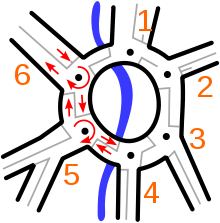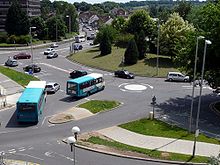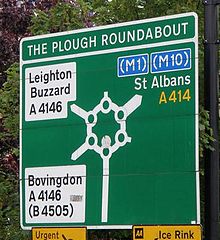- Magic Roundabout (Hemel Hempstead)
-
 Line drawing of the roundabout in its first configuration. The road labelled '2' is the dual-carriageway St Albans Road and provides the main access to Hemel from the M1 motorway.
Line drawing of the roundabout in its first configuration. The road labelled '2' is the dual-carriageway St Albans Road and provides the main access to Hemel from the M1 motorway.
The Magic Roundabout in Hemel Hempstead, Hertfordshire, England is the familiar name given to a complex road junction also known as the Moor End or Plough roundabout. The familiar name comes from the children's television programme of the same name and is also used for a similar junction in Swindon. The official name relates to a former public house which faced the junction between Lawn Lane and Two Waters Road called The Plough, and being at the Boxmoor end of the town.
Contents
Description
Despite its name, the magic roundabout is not actually a roundabout. It was constructed in 1973 to reduce the congestion at the original standard layout roundabout where seven roads intersected, it was one of the first bi-directional roundabouts to be constructed in the UK. At the junction of each road with the roundabout a mini-roundabout is present and subject to the normal clockwise direction of travel for all traffic. Between these mini-roundabouts however traffic is permitted to travel clockwise or anti-clockwise around the larger roundabout, the expectation being that drivers would choose the shorter route with less stationary traffic.
The Magic Roundabout in Hemel Hempstead was voted the UK's second-worst roundabout in a 2005 poll held by an insurance company (the winner being its Swindon counterpart). [1]
In 2011 the roundabout was voted the best in Britain by motorists in a competition organised by a car leasing service. [2]
Early history
The original magic roundabout had six exits in total, with the British Petroleum building spanning "Marlowes", the road leading to the town centre, in the approximate position of the earlier railway Viaduct. The BP building was found to be unstable due to defective reinforced concrete and the exit had to be closed. This building was later demolished and the original route not restored, although a newer side exit from the roundabout replaced the junction with Marlowes off a side road.
Prior to this design, a number of schemes were tried, including widening some of the entrances to and exits from the roundabout: ultimately a spiral roundabout was trialled. The idea behind this scheme was that drivers were supposed to enter the clockwise only roundabout, go to the center and then, about two exits before their chosen exits get into a lane that would spiral them off. The spiral idea failed, as many drivers ignored the lane markings, while those who followed the spiral tended to accelerate as they went round.
The present scheme opened in June 1973 and caused tailbacks allegedly to Berkhamsted, and up St Alban's Road, almost as far as the M1 in the other direction. A police officer had to be stationed at each of the mini roundabouts to prevent chaos.
When the new junction was first opened, a camera was placed overlooking the roundabout on the roof of the adjacent Kodak HQ building. It was noted many drivers would get 'lost' and make repeated reversals of direction between joining the roundabout and eventually leaving it.
Shortly after the opening the driver of an articulated lorry ended up in the River Gade in the centre of the roundabout after brakes failed while travelling down St Albans Road.
Other complex roundabouts
- Magic Roundabout (Swindon), one such roundabout in Swindon
- Magic Roundabout (Colchester), another such roundabout in Colchester
- Sadler's Farm Roundabout, a Magic Roundabout near Southend-on-Sea, Essex
References
- ^ Brits vote on the best and worst roundabouts, 20 December 2005, retrieved on 2008-01-18
- ^ We’re the top roundabout? That’s Magic! , Hemel Gazette, 20 May 2011,
External links
Categories:- Magic roundabouts in England
- Road junctions in England
- Transport in Hertfordshire
- Hemel Hempstead
Wikimedia Foundation. 2010.


